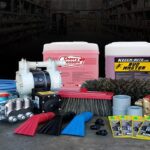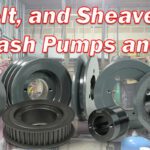In this edition of “Fix It with Phil”, he provides a step-by-step guide to help you install a Vacuum Dualer on your car wash vacuums.
Why Add a Dualer?
The Dualer allows you to offer both a claw and crevice tool to customers who use your vacuums. This allows them to easily switch between tools as they clean their vehicles. Customers can easily vacuum floors and seats using the claw. Plus, they can use the crevice tool to remove dirt in hard-to-reach areas such as storage space on doors, between the seats, and under the seats. By offering more tools, customers will spend more time using your vacuums, which results in a higher profit for you!
Now let’s show you how to install a Dualer.
Step 1: Drill Holes
The first thing you need to do is to drill holes around the suction port. This prepares the vacuum to accept a Dualer. Line up the holes, mark them, and drill into the metal of the vacuum. Phil recommends using a slow speed to prevent the bit from overheating. Now the vacuum is ready to accept a Dualer.
Step 2: Add a Gasket
Vacuum Dualers are NOT equipped with a gasket. However, the gasket is an essential component because it creates a seal to prevent air from escaping the point where the Dualer connects with the suction port on the vacuum. Adding a gasket ensures your vacuum delivers the best performance for customers.
Phil uses a vacuum motor gasket with an outer diameter measuring five inches and an inner diameter measuring two inches. He cuts slits around the inner circle. This allows the gasket to flex so it fits around the suction tube on the Dualer. Cutting the gasket is required because it is not the correct size, but is very close.
Once the slits are cut, peel the backing off the gasket to expose the adhesive. Slide it over the suction port connection on the Dualer. Make sure the sticky side is facing towards the surface of the Dualer. When the gasket is installed, you will see the tabs sticking up. Cut them off. Phil used a knife to do this. Please be careful when cutting off the tabs to avoid injury!
Phil also mentioned silicone spray is a great alternative to create the seal between the Dualer and the vacuum. He used a gasket because he had a spare one lying around.
Step 3: Install the Dualer
Place the Dualer on the suction port of the vacuum. Line it up with the holes you drilled. Start the screws, but don’t send them home yet. Verify the Dualer is flush with all three holes. Now, you can send the screws home. Once the screws are tight the Dualer is fully installed. There is one last thing to do. If your guess is adding hoses, you are correct!
Step 4: Attach Hose
When adding the hoses, first slide a hose clamp over each suction port of the Dualer. Don’t tighten the clamps yet. Wait until the hose is in place. To attach the hose, you need to push it into the correct suction port on the Dualer and tighten the clamp to secure it. That’s all there is to it!
Now you are ready to successfully install a Dualer on your car wash vacuums! By having this feature on your vacuums, customers will have the tools they need to clean larger areas inside their vehicles and get those spots that are hard to reach. Plus, they will spend more time at your vacuums, which equals more money in your pocket at the end of the day!
Watch Phil install the vacuum dualer.
About the Author
Phil Donnelly, aka Fix-It Phil
Kleen-Rite Equipment Engineer, Production Manager, Car Wash Operator
Best known for his “Fix-It Phil” persona on Kleen-Rite’s YouTube channel and podcast Kleen-Rite Radio, Phil Donnelly has become a trusted source of technical expertise for car wash owners, operators, and technicians. Beyond his on-screen guidance, Phil was the driving force behind the Operator Pro Plus pump stand, leading its design, testing, and production to create a highly effective solution for self-serve car washes. He also serves as the lead engineer and production manager for KR Equipment, our reliable line of car wash equipment designed and produced in-house specifically for the self-serve segment of the industry.
Before joining Kleen-Rite, Phil spent over 14 years servicing industrial boilers at Delval Equipment. This experience provided a strong technical foundation, enabling him to quickly master the equipment used in car washes due to the similarity of the required skills and knowledge. Phil attended Thaddeus Stevens College of Technology and graduated from the HVAC-R program with an Associate Degree.
















